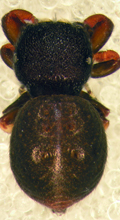Latest News Archive
Please select Category, Year, and then Month to display items
02 April 2025
|
Story Nomonde Mbadi
|
Photo Supplied

We wish to inform you of a technical challenge that has affected the performance of our Online Application portal since its opening on 1 April 2025. In close collaboration with our ICT department, the Directorate of the Registrar is actively working to address these issues to restore optimal functionality.
We understand the importance of this system for our prospective applicants and are committed to resolving the challenges swiftly. Your patience and understanding during this period is greatly appreciated.
Should you receive queries regarding this matter, please advise stakeholders that our team is fully engaged in rectifying the situation; we are optimistic about a timely resolution.
Thank you for your continued support and cooperation.
Director: Student Recruitment Services
UFS entomologists describe a new spider species
2014-02-19
|
 |
It is about 3mm in size and almost looks like a ladybird, but this new spider is the cause of great excitement at the University of the Free State’s (UFS’s) Department of Zoology and Entomology.
The new species of spider, now known as Rhene amanzi, was recently described for the first time and was ‘introduced’ to other arachnologist at the recent congress of the African Arachnology Society at Amanzi Private Reserve.
Dr Charles Haddad, senior lecturer in the UFS’s Department of Zoology and Entomology, said they already stumbled upon the male spider in 2010 when a student was doing research at the reserve. After a very long process, the spider was described and a couple of weeks ago, whilst at the congress, they also found the female.
“Up to now we only know that the spider lives in trees in the Brandfort area. The range could be wider, but since it was only described recently, other arachnologists will only now be able to identify accurately.”
Dr Haddad says they still have to determine how many eggs the female is able to lay, what the spider’s life cycle looks like and what their habitual preferences are.
“What we do know is that it probably isn’t poisonous and that the spider imitates a ladybird in order to protect itself against predators.”